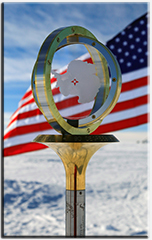About Antarctic Infrastructure and Logistics (AIL)
Section Head: Stephanie Short
Besides funding research, the U.S. National Science Foundation provides scientists with logistics, operational, and laboratory support in Antarctica. This includes a year-round inland research station at the South Pole (90° south latitude); two year-round coastal research stations (McMurdo at 78°S and Palmer at 64°S) with extensive laboratory and computing capabilities; summer camps (as required for research); icebreaking research ship--the RVIB Nathaniel B. Palmer (94 meters); U.S. Air Force and Air National Guard air transports; a fleet of ski-equipped LC-130 airplanes; Twin Otter and Basler airplanes; helicopters; U.S. Coast Guard and commercial icebreakers for channel breaking at McMurdo Station, treaty inspection missions and occasionally as needed for research support; a variety of oversnow vehicles; and automated, unmanned weather and geophysical observatories. Ships of the U.S. academic fleet and the ocean-drilling program on occasions also support research in Antarctica.
Air transport between New Zealand and McMurdo Station is provided several times per week in the austral summer from early October to the end of February. From McMurdo, the logistics hub, parties can access other sites, including the station at the South Pole. Winter flights to McMurdo are feasible if required. Between February and October the summer camps are closed and winter research is limited to the immediate environs of South Pole and McMurdo, where station residents are isolated as long as eight months.
Palmer Station, on Anvers Island in the Antarctic Peninsula region, is logistically isolated from the rest of the United States Antarctic Program and relies mainly on the research ship Laurence M. Gould (during or between research cruises) for transport of passengers and supplies to and from a port at the southern tip of South America. The ship makes several trips throughout the year. Laurence M. Gould provides onboard research support in marine biology, oceanography, and geophysics and can support science in other areas of the Southern Ocean. U.S. antarctic stations and ships provide both voice and data communications (including Internet) with locations outside Antarctica.
Through a contract with NSF, Leidos Antarctic Support Contract (ASC) provides a wide range of logistical and science support operations to the United States Antarctic Program. The U.S. Air Force and Air National Guard fly the large air transports like the LC-130s and C-17s; contractors provide the helicopters and smaller Twin Otter and Basler airplanes.
RELATED LINKS
U.S. Antarctic Program
- About the U.S. Antarctic Program
- Frequently asked questions about the U.S. Antarctic Program
- U.S. Antarctic Environmental Protection
- U.S Antarctic Policy
- U.S. Annual Antarctic Treaty Exchange of Information
Antarctic Science Programs
- Antarctic Astrophysics and Geospace Sciences
- Antarctic Organisms and Ecosystems
- Antarctic Earth Sciences
- Antarctic Glaciology
- Antarctic Ocean and Atmospheric Sciences
- Antarctic Integrated System Science
- Antarctic Artists and Writers Program
Office of Polar Programs Information
- Polar Programs Advisory Committee home page
- Polar Programs Advisory Committee Report on Broader Impacts Review Criterion
- Polar Programs-supported Workshops
Related Office of Polar Programs Antarctic Links
- Antarctic Artists and Writers Program
- Subglacial Lake Committee
- Polar Programs Guidelines and Award Conditions for Scientific Data
- OPP Office Advisory Committee Report on Broader Impacts Review Criterion
Antarctic Information Links
- Antarctic Sun (USAP online magazine)
- U.S. South Pole Station: A Special Report
- Antarctic Journal of the United States
- Cold Regions Bibliography project
- Antarctic Images (Program information slides)
- USAP Online Photo Library
Office of Polar Programs Links
- Opportunities for Participation
- Committee of Visitors reports and Government Performance Results Act (2000 – 2009 reports)

The 2015 South Pole geographic Pole marker. Each austral winter a new marker is designed and fabricated by personnel at the station for the next calendar year. (NSF/USAP photo by Dean Hancock.)
